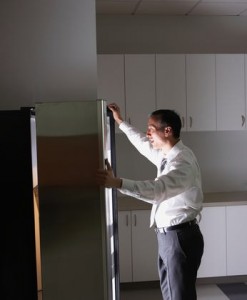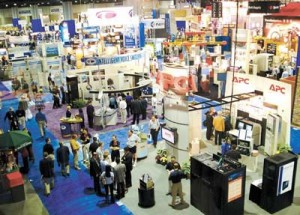Please tell me you know what I am talking about. Prompted by an unsatisfied feeling in your stomach, you wander into the kitchen, open the refrigerator door, and stare deeply into the depths of the cold, giant box. I have been doing this since I was a kid. Sometimes, I even pull a double where I have both the refrigerator and freezer doors open simultaneously. This drives my wife nuts! She says it wastes money, and can affect the contents in the refrigerator. She is actually right on this one. Shouldn’t I have a plan before I look into the refrigerator, freezer, or pantry? Then I think to myself, is there a lesson here for education?
Many administrators throughout the world are doing the “Open Refrigerator Stare” in their schools. Here is how it goes. Once we know the curricular shelves are stocked, we wonder curiously down hallways and begin opening doors, classroom doors.
Some of our purchases are front and center. They look as delicious as they did in the store and gulp, we eat it right up. But as we stare longer, we notice numerous items in the back, sometimes piled on top of each other. We may remember buying them, or not. Some of these things have really nice packaging, but when we open them up they spoil quickly. Still others don’t have a very long shelf life, bruise easily, and we just end up staring at them. Often partially satisfied or even unsatisfied, we close the door.
Invariably, someone goes shopping again and announces, “The new packages are in!” Then, we begin the process all over by packing the refrigerator, freezer, and pantry. Sometimes we throw out dated items, sometimes we think maybe we will use them later, and other times we store them somewhere else. Either way, it all gets packed in there.
So, how do we thwart the Open Refrigerator Stare and subsequent wasteful practices that plague Education? The plan is simple-we need to refine our practices and operationalize a methodical and process-centered system that is focused on results. The results can be anything from saving money, improved student achievement, increased professional development. It really depends on what you want in the refrigerator.
Systems thinking
According to Senge (1990) systems thinking is the process that helps leaders perceive how aspects of the organization influence each other. For instance, in schools, there is a system of influences on student performance. In addition to teachers, there are parents, bus drivers, cafeteria workers, secretaries, Board of Education, administration, technology, laws, mandates, nutrition, etc. that impact students. If everyone understands that they are part of the “system” and understand the mission/vision of the system, then the system is dedicated to student achievement. Seems easy, right? Well, it isn’t.
Process Centered not people centered
Hammer (1996) coined the phrase “process-centered” to describe the importance of organizations’ understanding their own processes. For a school, this is a way to view all purchases, interactions, curriculum, etc. in terms of the mission/vision as opposed to someone with a “bright idea” or “money to spend.” In order for process-centered to work, people have to put aside their positions, personal beliefs, and power struggles to do what is in the best interest of the organization. Under a process-centered school district, the central administration (with a balcony view of the district) becomes more of a “quality control” focusing on the inter-working parts of all the schools, curriculum, etc with the mission/vision driving the way.
Focused on Results
W.E. Demmings coined the phrase “We inspect what we expect.” He believed that organizations, if focused on quality, needed to follow a simple mathematical equation: “Quality= Results of work/ Total costs.” In education, we have been accustomed to our “feelings.” Often administrators will say, “I feel our students are not behaving lately!” The first question, in response to that, would be, “How do you know?” Then you would ask, “What data do you have to support that? Is it a trend? Was this an outlier of a month? Why? Why? Why? Why? Why?” Asking the right questions can lead us to create the necessary system or processes to achieve our goals, and overcome real (and perceived) problems.
See, it’s not that simple anymore to go on feelings. In fact, I believe the “feelings” of educators have us going in a million different directions. No wonder we are constantly being criticized and vilified in the press. What are really focused on? Do we have the capacity to tell our story, with appropriate data to support? Furthermore, if we want teachers to make data-based decisions, then we as administrators need to lead by example, and open the refrigerator door in a systemic, process-centered way that is focused on results.
Resources:
Hammer, M. (1996). Beyond Reengineering: How the Process Centered Organization is Changing Our work and Lives. HarperCollins Publishers, Inc. New York.
Senge, P. (1990). The Fifth Discipline: The Art and Practice of the Learning Organization. Currency Doubleday. New York.
Transforming Schools Through Powerful, Systemic Walkthroughs http://www.wix.com/missdiscepola/ascd12




